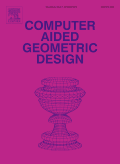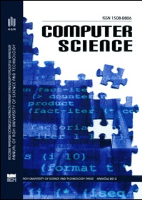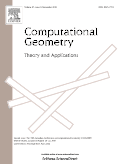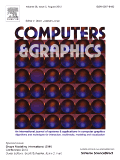
COMPUTER AIDED GEOMETRIC DESIGN
Scope & Guideline
Exploring the Intersection of Design and Engineering
Introduction
Aims and Scopes
- Geometric Modeling Techniques:
The journal emphasizes innovative techniques in geometric modeling, including the development of splines, Bézier curves, and Pythagorean-hodograph curves. These methods are crucial for creating smooth and flexible representations of shapes. - Computational Geometry and Algorithms:
A significant focus is on computational geometry, where researchers explore algorithms for shape analysis, mesh generation, and surface reconstruction. This area includes the application of advanced mathematical principles to solve geometric problems. - Applications in CAD and 3D Graphics:
The journal covers applications of geometric design in CAD systems, 3D modeling, and graphics, highlighting tools and techniques that improve design efficiency and accuracy. - Machine Learning and Data-Driven Approaches:
Recent publications show a growing interest in integrating machine learning with geometric design, indicating a trend towards data-driven methods for shape recognition, optimization, and reconstruction. - Analysis and Visualization of Geometric Data:
Research also delves into the analysis and visualization of geometric data, such as point clouds and meshes, focusing on how to effectively interpret complex 3D structures.
Trending and Emerging
- Integration of Machine Learning:
Recent papers highlight the integration of machine learning techniques into geometric design, showcasing methodologies that leverage neural networks for tasks like shape reconstruction and mesh analysis. This indicates a growing intersection between AI and geometric modeling. - Advancements in 3D Shape Analysis:
There is an increasing trend towards advanced 3D shape analysis, including the use of persistent homology and topological descriptors. This focus on shape characterization reflects a broader interest in understanding geometric properties and their applications. - Real-Time and Interactive Design:
Emerging themes include real-time and interactive design methods, particularly in the context of CAD and gaming. This trend emphasizes the need for tools that allow for instant feedback and modification of geometric models. - Point Cloud Processing:
Research on point cloud processing has surged, with papers exploring methods for effective reconstruction, segmentation, and analysis. This reflects the growing importance of point clouds in applications like 3D scanning and modeling. - Geometric Deep Learning:
The rise of geometric deep learning, which applies deep learning techniques to geometric data, is evident in recent publications. This trend signifies a shift towards utilizing complex data structures and leveraging their geometric properties for enhanced model performance.
Declining or Waning
- Traditional CAD Techniques:
There appears to be a decrease in papers focused solely on traditional CAD techniques that do not incorporate modern computational methods or technological advancements. This shift suggests a movement towards more integrated and innovative approaches. - Basic Geometric Constructs:
Research on basic geometric constructs such as simple curves and surfaces has become less prevalent. As the field evolves, there is a greater emphasis on complex, multi-faceted designs that require sophisticated modeling techniques. - Static Geometric Representations:
There is a noticeable decline in studies related to static geometric representations, as dynamic and interactive modeling approaches gain popularity. Researchers are increasingly focusing on real-time applications and adaptive methods.
Similar Journals

JOURNAL OF DIFFERENTIAL GEOMETRY
Elevating mathematical discourse through rigorous research.JOURNAL OF DIFFERENTIAL GEOMETRY, a premier publication by INT PRESS BOSTON, INC, has established itself as a leading forum for the dissemination of high-quality research in the fields of differential geometry, algebra, and analysis. With an impressive history that spans from 1967 to 2024, this journal is recognized for its rigorous peer-reviewed articles, contributing significantly to the advancement of mathematical theories and innovative approaches. Notably, the journal boasts a Q1 ranking in key categories such as Algebra and Number Theory, Geometry and Topology, and Analysis, reflecting its pivotal role within the mathematics community. Its Scopus rankings reinforce its reputation, placing it among the top-tier journals in its respective fields, with a 97th percentile ranking in Algebra and Number Theory, further emphasizing its influence. While the journal does not offer Open Access options, it remains a critical resource for researchers, professionals, and students aiming to stay at the forefront of developments in differential geometry and related domains. Engage with groundbreaking research and explore new methodologies that are shaping the future of mathematics.

Computer Science-AGH
Advancing the Frontiers of Computer Science ResearchComputer Science-AGH, published by the AGH University of Science & Technology Press in Poland, is an esteemed open access journal that has been disseminating high-quality research since 2004. With ISSN 1508-2806 and E-ISSN 2300-7036, this journal focuses on a diverse range of areas within the computer science discipline, including but not limited to Artificial Intelligence, Computational Theory, Computer Graphics, and Networks. While it currently holds a Q4 ranking across several categories as of 2023, it actively promotes research that contributes to the academic community's understanding and evolution in the field. The journal's commitment to open access ensures that vital research is accessible to a wider audience, fostering collaboration and innovation. With its comprehensive focus and strategic publication goals, Computer Science-AGH plays a crucial role in advancing the frontiers of computer science research and education, making it an invaluable resource for researchers, professionals, and students alike.

COMPUTATIONAL GEOMETRY-THEORY AND APPLICATIONS
Empowering Researchers with Cutting-edge Geometry InsightsCOMPUTATIONAL GEOMETRY - THEORY AND APPLICATIONS is a premier academic journal published by Elsevier, specializing in the interdisciplinary field of computational geometry. Since its inception in 1991, this journal has had a significant influence on the advancement of computational mathematics, offering a platform for innovative research that explores the theoretical and applied aspects of geometry and its applications in various scientific domains. With a 2023 impact factor placing it in the Q2 category for Computational Mathematics and Geometry and Topology, researchers can trust the rigor and relevance of the work published here. While the journal does not currently offer an open-access option, it remains highly influential, ranked in the mid-range percentile across multiple categories including Computational Theory and Mathematics and Control and Optimization. Therefore, it serves as an invaluable resource for researchers, professionals, and students passionate about pushing the boundaries of knowledge in computational geometry and its myriad applications. The ongoing publication commitments extend until 2025, further solidifying its role in shaping the future of this dynamic field.

COMPUTERS & GRAPHICS-UK
Elevating the Standards of Computer-Aided DesignCOMPUTERS & GRAPHICS-UK is a premier journal dedicated to the fields of computer graphics, computer-aided design, and human-computer interaction. Published by Pergamon-Elsevier Science Ltd, this esteemed journal has been a critical resource for researchers and professionals since its inception in 1975. With an impressive impact factor and ranked in the second quartile for key disciplines such as Computer Vision and Pattern Recognition, and Engineering (Miscellaneous), it provides a platform for high-quality, peer-reviewed research spanning theoretical advancements, innovative technologies, and practical applications. Notable for its interdisciplinary approach, the journal also embraces contributions that bridge diverse areas within computer science. Although lacking Open Access options, readers can benefit from its rich archive and cross-disciplinary insights, making it essential for anyone looking to advance their knowledge and practice in computer graphics and related fields. The journal is located in the United Kingdom, at The Boulevard, Langford Lane, Kidlington, Oxford OX5 1GB, and continues to be a cornerstone for scholarly exchange and advancement in the digital visualization domain.

Advances in Computational Design, An International Journal
Bridging Theory and Practice in Computational DesignAdvances in Computational Design, an esteemed international journal published by TECHNO-PRESS, focuses on the dynamic intersection of computational mathematics, mechanics, and computer graphics. This journal provides a platform for researchers and practitioners alike to contribute to the rapidly advancing fields of computational design, fostering innovation in methodologies and applications. With a ranking placing it in the Q4 category for Computational Mathematics and in the Q3 categories for both Computational Mechanics and Computer Graphics, it is recognized for its impact within academic and professional circles. Given its launch in 2016, the journal has cultivated a significant community of scholars aiming to push the boundaries of computational techniques. The Scopus rankings demonstrate its visibility and relevance, with notable positions in key categories. Although the journal operates under a traditional subscription model, the rich array of research articles available through its platform continues to enrich scholarly dialogue and advance understanding in the field. For those pursuing cutting-edge developments in computational design and its applications, Advances in Computational Design serves as an invaluable resource.

Computational Visual Media
Unlocking the potential of visual media through technology.Computational Visual Media, published by TSINGHUA UNIVERSITY PRESS, is a premier open access journal dedicated to advancing the fields of Artificial Intelligence, Computer Graphics and Computer-Aided Design, and Computer Vision and Pattern Recognition. Since its inception in 2015, it has established a robust position within the academic community, consistently achieving Q1 rankings across its categories as of 2023. With exceptional Scopus rankings, including a remarkable percentile standing in the top 10% globally, the journal serves as a vital resource for researchers, professionals, and students eager to explore cutting-edge methodologies and technologies in computational visual media. The journal’s open access format enhances accessibility, fostering global collaboration and dissemination of knowledge, making it an indispensable platform for those at the forefront of innovation in these dynamic fields. The journal is headquartered in Beijing, China, and aims to publish high-quality research that not only contributes to theoretical advancements but also addresses practical challenges within computational visual technologies.

ANNALI DELLA SCUOLA NORMALE SUPERIORE DI PISA-CLASSE DI SCIENZE
Elevating Academic Discourse in Mathematics and Computer ScienceANNALI DELLA SCUOLA NORMALE SUPERIORE DI PISA-CLASSE DI SCIENZE is a prestigious academic journal published by the SCUOLA NORMALE SUPERIORE in Pisa, Italy, specializing in the fields of mathematics and theoretical computer science. With an impressive Q1 ranking in both categories for 2023, it stands out in the academic community, recognized for its rigorous peer-reviewed research and impactful findings. Although it does not currently offer open access, the journal is widely regarded for its academic contributions and has converged from 1996 to 2024, enhancing its rich legacy in scientific discourse. Researchers, professionals, and students alike will find the journal an essential resource, given its high Scopus rankings, placing it in the upper echelons of its field. For those looking to advance their understanding and explore cutting-edge findings in mathematics and computer science, ANNALI DELLA SCUOLA NORMALE SUPERIORE DI PISA is an indispensable platform for scholarly exchange.

Advanced Studies-Euro-Tbilisi Mathematical Journal
Unlocking the Secrets of Mathematics TogetherAdvanced Studies-Euro-Tbilisi Mathematical Journal, published by the esteemed TBILISI CENTRE MATH SCI, is a vital resource for scholars and practitioners in the field of mathematics. Since its inception in 2021, this journal has committed to advancing knowledge across various mathematical disciplines, including Algebra and Number Theory, Analysis, Applied Mathematics, and Geometry and Topology, although it currently holds a category quartile ranking of Q4 in all these areas. With an open-access format, it provides unparalleled access to cutting-edge research to a global audience of researchers, professionals, and students, fostering collaboration and innovation within the mathematical community. Operating from TBILISI, Georgia, the journal acknowledges the growing importance of diverse geographical contributions to mathematics and aims to spotlight emerging research trends. As research continues to evolve, Advanced Studies-Euro-Tbilisi Mathematical Journal seeks to enrich the academic dialogue and support the dissemination of mathematical knowledge.

Annals of the University of Craiova-Mathematics and Computer Science Series
Unlocking Potential: Bridging Mathematics and Computer ScienceAnnals of the University of Craiova-Mathematics and Computer Science Series, published by UNIV CRAIOVA, is a distinguished academic journal that serves as a platform for advancing knowledge in the fields of mathematics and computer science. With an ISSN of 1223-6934 and an E-ISSN of 2246-9958, the journal has been disseminating high-quality research since its inception in 2011 and is targeted toward researchers, professionals, and students from these dynamic fields. It has been recognized in the Q3 category for both Computer Science Applications and Mathematics (miscellaneous) as of 2023, highlighting its emerging influence in the academic community, despite its current Scopus Rankings placing it at 42nd percentile for Mathematics and 14th percentile for Computer Science Applications. The journal's commitment to open access and its ongoing contributions until 2024 position it as a vital resource for fostering collaboration and innovation in Romania and beyond. Researchers interested in mathematics and computer science will find valuable insights and cutting-edge studies within its pages.

DISCRETE MATHEMATICS
Illuminating the path for future mathematical innovations.DISCRETE MATHEMATICS, published by Elsevier, is a leading journal dedicated to the field of discrete mathematics and combinatorics, with a distinguished presence in the academic community since its inception in 1971. With an ISSN of 0012-365X and an E-ISSN of 1872-681X, this esteemed journal has firmly established itself within the Q1 category for Discrete Mathematics and Combinatorics, and Q2 for Theoretical Computer Science as per the 2023 metrics, underscoring its pivotal role in advancing research in these vital areas. DISCRETE MATHEMATICS is highly regarded, reflected in its Scopus rankings, where it stands at #44 out of 92 in its primary category, contributing significantly to the global discourse on complex mathematical theories and applications. Published from the Netherlands, the journal serves as a crucial resource for researchers, professionals, and students looking to stay informed about the latest innovations and methodologies in discrete mathematics. Though currently not an open-access journal, DISCRETE MATHEMATICS continues to foster a vibrant scholarly community through rigorous peer-reviewed research, promoting a deeper understanding of the mathematical structures that underpin both theoretical and applied science.